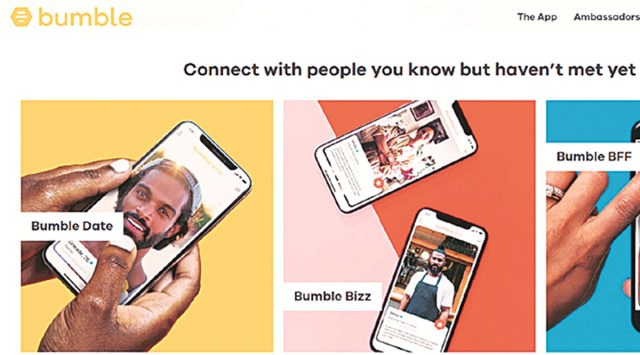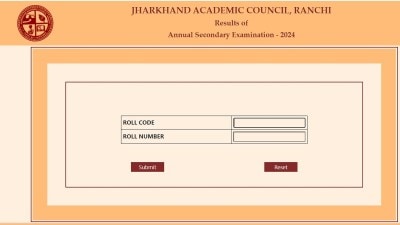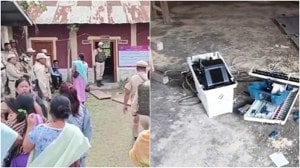- India
- International
Surge in dating apps in Tier-II cities, but skew against women
India is the second-largest revenue market for dating apps, after the US, with $323 million in revenue in 2020, according to Statisa.com.
 31 million Indian dating app users in 2020, 67% men
31 million Indian dating app users in 2020, 67% menWHEN NIHARIKA Singh first used dating app Bumble in her hometown of Lucknow in 2018, she found that after a few swipes, there were no more potential partners. But after she got stuck at home following the lockdown last year, the 24-year-old found a whole new crop of men on such apps, many of them back at home like her.
“They would send me non-stop offers,” she said, after deleting the apps in December. “I don’t think I’ll use the apps in Lucknow ever again. I found that here, men were too psychologically desperate to meet — that was not the case in Delhi, Mumbai, Bangalore. The experience difference between a girl and a guy is huge, especially here. I am suffering from a problem of abundance.”
Across India, dating app executives have noted an unexpected Covid effect: the growth of users in cities outside the metros, without any specific marketing push. And, a persistent and growing gender imbalance: out of the 31 million Indian dating app users in 2020, 67 per cent were men.
India is the second-largest revenue market for dating apps, after the US, with $323 million in revenue in 2020, according to Statisa.com.
A Tinder spokesperson told The Indian Express that growth in Tier-II cities has grown twice as much as the metros in the past year. Happn, one of the most popular apps in India with 28 million users, now has Nagpur, Surat, Ludhiana, and Agra in its top 20 cities. “Because of the pandemic, smaller cities are rising in terms of new members or activity on the app,” said Marine Ravinet, Head of Trends at Happn.

Truly Madly, an Indian dating app with 7.8 million users, found that, out of cities with a revenue base in lakhs, those like Bhubaneshwar, Jammu, Kanpur, Patna, Rajkot, Varanasi, and Vijaywada have seen a seven-fold revenue growth since the pandemic — much more than the metros. “One factor could be reverse migration as our small town growth accelerated in March… We also saw the peak time for usage shift from 11 pm to 2 am,” said Snehil Khanor, CEO of TrulyMadly, which has 7.8 million users in India.
“We did see, especially in the engineering community, that people moving out of Bangalore and Hyderabad led to traffic spiking in Tier-II cities,” said Able Joseph, CEO of Aisle, an Indian dating app with 2 million unique users in 2020.
Almost all growth in 2020 came outside the Tier-I market, statistics provided by the company show.
Those who have travelled between metros and small towns over the last few months also speak of differences in how the apps are used. Profiles often hide real identities, especially for women, highlighting a lingering stigma and trust deficit with online dating. “Photos of mandirs, Katrina Kaif, or just a black box,” said Sandeep Mertia, a media researcher who has been on an array of apps for seven years for both personal and research use as he has travelled between Delhi, New York, and his hometown, Jodhpur. “Instead, there are bios with Rajputini, Jat and other caste labels similar to what we see on the back of cars. Women hide their names, writing R, S, or A. Once you come back to your hometown, these changes become more apparent to you,” he said.
When Mertia first used Tinder in Jodhpur in 2015, he swiped left four times and the app told him there was no one else to show in his area. But he noticed a swell to triple digits in 2017, just as the country saw its Internet users surge with the decline in data costs. This March, when he returned due to the lockdown, he saw another unprecedented spike.
“A whole new crowd of reverse migrants from Bangalore, Hyderabad, or the UK were stuck at home and on these apps (Bumble, Tinder, and OkCupid). I saw profiles say ‘Forced here because of COVID,’ ‘Only here because of COVID,’ ‘Bored to death because of COVID and therefore here’,” said Mertia, a 29-year-old completing his Ph.D. in digital media at New York University.
Joseph, from Aisle, acknowledges other hurdles to the small town dating app space, from not having an anonymous place to meet and issues of authenticity. His company has used last year’s shift to begin marketing his app as a marriage-focused platform to overcome the stigma, especially outside large metros.
Take the case of Simar, who is in his 20s and preferred to keep his surname anonymous.
For the first time in six years, Simar returned to Jalandhar after studying in Sweden. He downloaded the app in November when he found it hard to find like-minded friends. “In the midst of the pandemic, there was no other way to meet people. I figured why not give it a shot. But in my town, dating is still considered taboo. Arranged marriage is still predominant around me. All the women were hiding their faces and names on the app. I uninstalled it last month,” he said.
Apr 19: Latest News
- 01
- 02
- 03
- 04
- 05






































